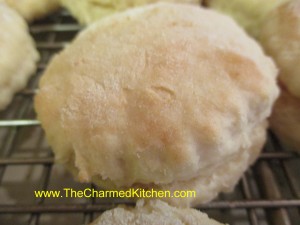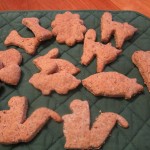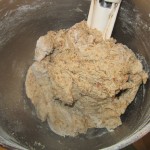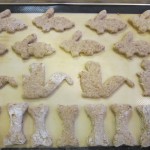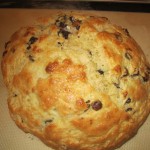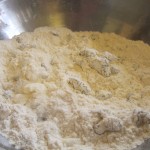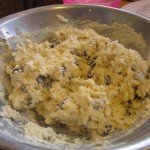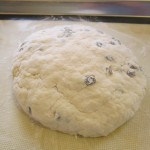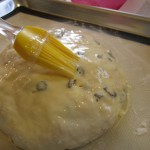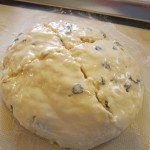Cream Scones
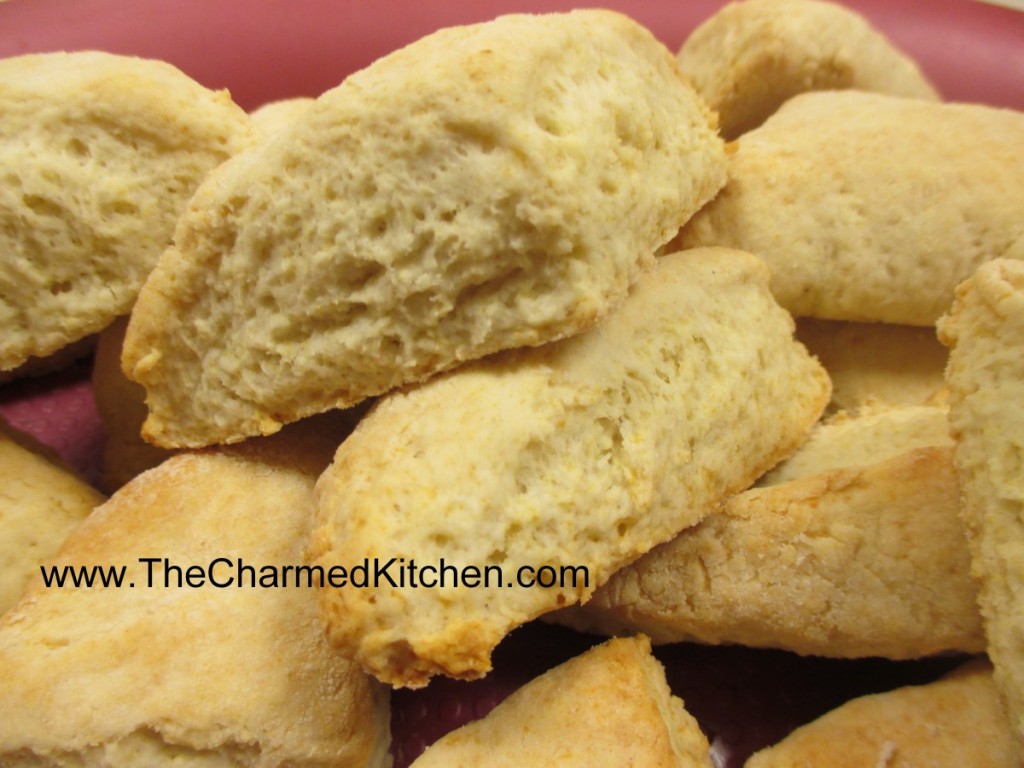
I must admit that for me, the difference between a scone and a biscuit is sometimes hard to see. Both use the same ingredients, for the most part. They can be rolled and cut out the same way, too. I often say that scones are like biscuits, but with more stuff in them. Scones are often sweeter, too.
This recipe is a tough call for me. I was given the recipe by a friend a long time ago. She called them Cream Scones. I could easily see calling them Cream Biscuits, instead. Whatever you call them, these little gems are tender, flaky and super easy to make. You can make variations with all sorts add ins. I recently made some with mini chocolate chips and orange zest. They also are great for shortcakes!!
Cream Scones
2 c. flour
1 T. sugar
½ t. salt
1 T. baking powder
1 c. heavy cream
Preheat oven to 425 degrees. Sift together dry ingredients and gradually add cream to form soft dough. Knead lightly on a floured board until dough sticks together. Roll to ½ – ¾ –inch thickness and cut with 2-inch biscuit cutter. Re-roll scraps and continue cutting, handling dough as little as possible.* Place on baking sheet and bake 10-12 minutes or until golden. Makes 8-10.
* Instead of rolling them out and cutting into rounds, I pressed the dough into an 8-inch square. I cut the square into 4 smaller squares. I then cut and “x” across each of the four squares, making 4 triangles (16 in all). Bake as directed above.
Here is the cut out version made in class last week
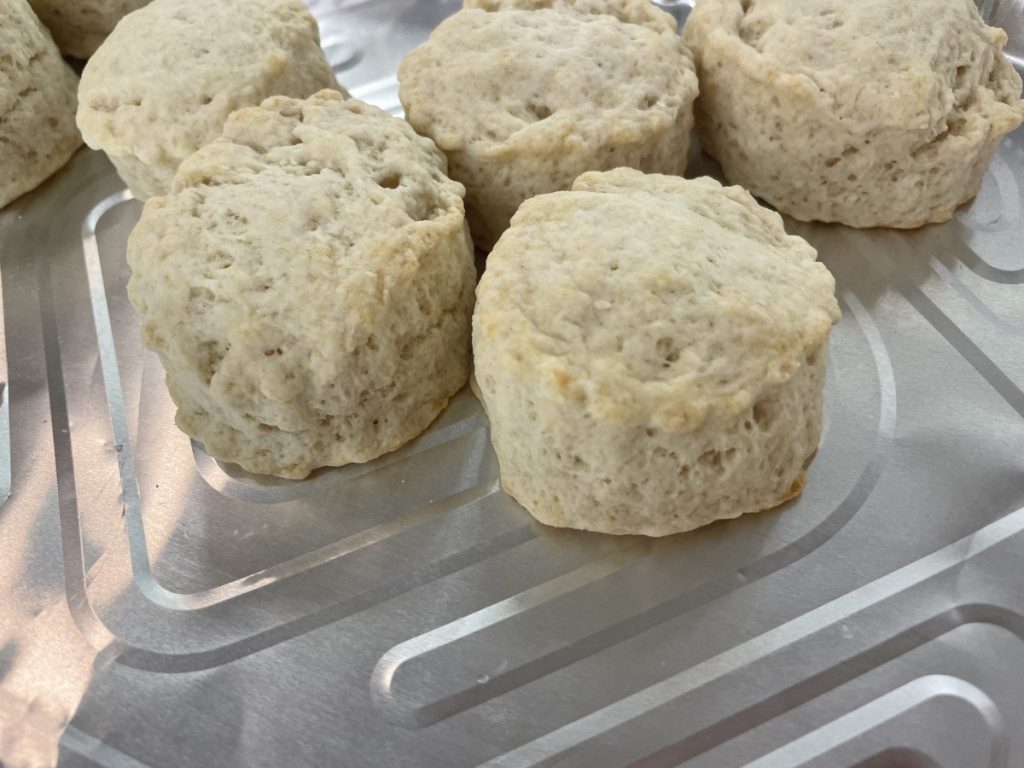
The Gentle Art of Biscuits
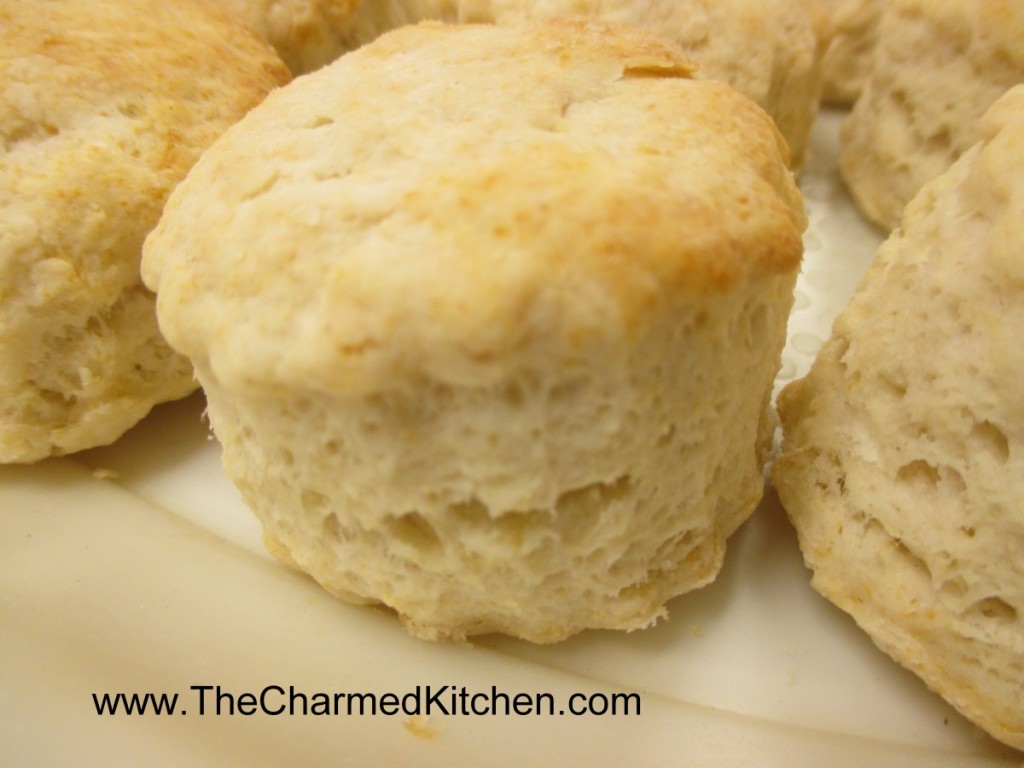
Biscuits are easy to make. They really are. Fast, too. You can mix up a batch of biscuits in the time it takes the oven to preheat. Yet, I know people who seem to struggle with them. In class last night, we talked about the secret to a light and flaky biscuit.
So what goes wrong? How do you make light, flaky biscuits every time?
For the moment I’ll assume you have a decent recipe. There are a lot of great biscuit recipes out there. I know people that have treasured family recipes. Biscuits that have been made the same way for generations.
Assuming also, that the baking powder is fresh*, there has to be some other reason that some folks just seem to struggle with biscuits.
The problem is, more than likely, over-mixing the dough. When I talk to someone who tells me that their biscuits are always heavy or tough, I first ask about how they are put together. Less is more, when it comes to biscuits. Less handling of the dough, more tender the biscuits.
Once the dry ingredients have been mixed and the fat cut in, there is just liquid to be added. I prefer to chill whatever fat I am using.
At this point the dough should be handled just enough to hold together. A light hand means a light biscuit. The same is true for making scones. The more you knead the dough, handle the dough and roll the dough, the less flaky biscuits become. Be gentle with your dough.
Don’t treat biscuit dough the way you would a yeast-based dinner roll. The two are very different in how they are handled. Yeast-based doughs benefit from kneading and “working” the dough. Biscuits are the opposite.
Even when cutting out the biscuits, it will help if you cut them out as close together as you can. That way you have fewer scraps to re-roll. Every time you roll the dough out- it becomes a little tougher. You can always roll or pat your dough into a square and cut out the biscuits into triangles, leaving no scraps and no re-rolling.
Here is a recipe for one of my favorite biscuits. They are light and very flaky. Is there anything better than a fresh, warm biscuit with some butter?
Biscuits Supreme
2 c. flour
4 t. baking powder
2 t. sugar
½ t. cream of tartar
½ t. salt
½ c. cold butter, shortening or coconut oil – you can even use lard
2/3 c. milk
Stir together dry ingredients and cut in butter to resemble coarse crumbs. Make a well in the center and add milk all at once. Stir until dough sticks together and knead on lightly floured surface 10-12 strokes. Roll or pat to ½ inch thickness. Cut with 2-21/2 inch biscuit cutter and place on ungreased baking sheet. Bake in 450-degree oven for 10-12 minutes. Serve warm. Makes 10-12.
Note: We made two batches of these biscuits in class last night. One with butter and the other with shortening, to compare them side by side. Both handled and rose perfectly. A few people said the shortening biscuits were flakier. I make no judgements about what fat you choose to use in your biscuits. I use butter most often, unless I am serving them to someone who doesn’t eat butter/dairy for some reason. .
*If your baking powder might be old, you can test it. Place a couple of tablespoons of boiling water in a cup. Add a teaspoon, or two, of baking powder. The mixture should bubble vigorously. If there are no bubbles, or very few bubbles, you might want to get a new container of baking powder.
Sweet Potato and Herb Biscuits
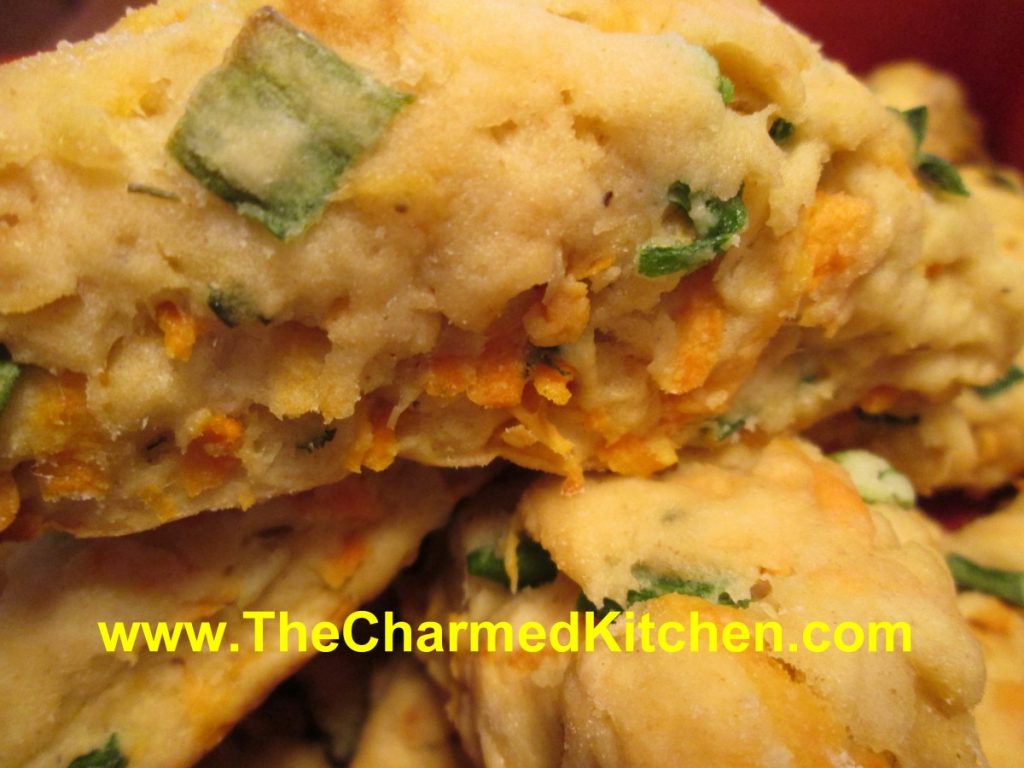
These biscuits are a favorite of mine. They go great with a bowl of chili. They also would make a nice addition to your Thanksgiving table.
I like sweet potatoes any number of ways. Steamed, roasted, mashed. In this biscuit recipe, raw sweet potatoes are grated and added to the dough, along with some herbs. The biscuits come out tender, with great flavor and texture. They are also quite pretty.
I enjoy them with a bit of butter, warm from the oven.
When you mix the dough, don’t be worried if it seems too dry. It takes a little bit of kneading to get the moisture out of the potatoes. The extra effort is worth it.
I cut them into triangles, but you can just form the dough into a log shape. Then, slice the dough for round biscuits. They taste wonderful, no matter the shape.
Sweet Potato and Herb Biscuits
2 1/4 c. flour
1 T. baking powder
1/2 t. grated lemon peel
1/4 t. each baking soda, dried basil and dried thyme
1 egg, beaten
1 1/2 c. shredded sweet potato, about 1 large
1/2 c. fine chopped green onions
1/2 c. sour cream
2T. butter, melted or olive oil
Stir together dry ingredients in large bowl and set aside. Combine remaining ingredients and add to flour mixture mixing until just blended. Turn onto lightly floured surface and knead a few times until dough just stays together. Dough will look too dry- but it will come together after you knead it. Press into an 8-inch square and cut into four squares.* Cross cut each square into four triangles. Place on greased baking sheet and bake in a preheated 425 degree oven for 20 minutes. Makes 16.
* I press the dough into a lightly floured 8×8-inch baking pan and then flip it out onto the work surface, before cutting. That way you’ll get nice, even edges.
The Gentle Art of Biscuits

Biscuits are easy to make. They really are. Fast, too. You can mix up a batch of biscuits in the time it takes the oven to preheat. Yet, I know people who seem to struggle with them. The other night, a friend and I were talking about the secret to a light and flaky biscuit.
So what goes wrong? How do you make light, flaky biscuits every time?
For the moment I’ll assume you have a decent recipe. There are a lot of great biscuit recipes out there. I know people that have treasured family recipes. Biscuits that have been made the same way for generations.
Assuming also, that the baking powder is fresh*, there has to be some other reason that some folks just seem to struggle with biscuits.
The problem is, more than likely, over-mixing the dough. When I talk to someone who tells me that their biscuits are always heavy or tough, I first ask about how they are put together.
Once the dry ingredients have been mixed and the fat cut in, there is just liquid to be added. I prefer to chill whatever fat I am using.
At this point the dough should be handled just enough to hold together. A light hand means a light biscuit. The same is true for making scones. The more you knead the dough, handle the dough and roll the dough, the less flaky biscuits become. Be gentle with your dough.
Don’t treat biscuit dough the way you would a yeast-based dinner roll. The two are very different in how they are handled. Yeast-based doughs benefit from kneading and “working” the dough. Biscuits are the opposite.
Even when cutting out the biscuits, it will help if you cut them out as close together as you can. That way you have fewer scraps to re-roll. Every time you roll the dough out- it becomes a little tougher. You can always roll or pat your dough into a square and cut out the biscuits into triangles, leaving no scraps and no re-rolling.
Here is a recipe for one of my favorite biscuits. They are light and very flaky. Is there anything better than a fresh, warm biscuit with some butter?
Biscuits Supreme
2 c. flour
4 t. baking powder
2 t. sugar
½ t. cream of tartar
½ t. salt
½ c. cold butter, shortening or coconut oil – you can even use lard
2/3 c. milk
Stir together dry ingredients and cut in butter to resemble coarse crumbs. Make a well in the center and add milk all at once. Stir until dough sticks together and knead on lightly floured surface 10-12 strokes. Roll or pat to ½ inch thickness. Cut with 2-21/2 inch biscuit cutter and place on ungreased baking sheet. Bake in 450-degree oven for 10-12 minutes. Serve warm. Makes 10-12.
*If your baking powder might be old, you can test it. Place a couple of tablespoons of boiling water in a cup. Add a teaspoon, or two, of baking powder. The mixture should bubble vigorously. If there are no bubbles, or very few bubbles, you might want to get a new container of baking powder.
The Art of Biscuits

Biscuits are easy to make. They really are. Fast, too. You can mix up a batch of biscuits in the time it takes the oven to preheat. Yet, I know people who seem to struggle with them. The other night, a friend and I were talking about the secret to a light and flaky biscuit.
So what goes wrong? How do you make light, flaky biscuits every time?
For the moment I’ll assume you have a decent recipe. There are a lot of great biscuit recipes out there. I know people that have treasured family recipes. Biscuits that have been made the same way for generations.
Assuming also, that the baking powder is fresh*, there has to be some other reason that some folks just seem to struggle with biscuits.
The problem is, more than likely, over-mixing the dough. When I talk to someone who tells me that their biscuits are always heavy or tough, I first ask about how they are put together.
Once the dry ingredients have been mixed and the fat cut in, there is just liquid to be added. I prefer to chill whatever fat I am using.
At this point the dough should be handled just enough to hold together. A light hand means a light biscuit. The same is true for making scones. The more you knead the dough, handle the dough and roll the dough, the less flaky biscuits become.
Don’t treat biscuit dough the way you would a yeast-based dinner roll. The two are very different in how they are handled. Yeast-based doughs benefit from kneading and “working” the dough. Biscuits are the opposite.
Even when cutting out the biscuits, it will help if you cut them out as close together as you can. That way you have fewer scraps to re-roll. Every time you roll the dough out- it becomes a little tougher.
Here is a recipe for one of my favorite biscuits. They are light and very flaky. Is there anything better than a fresh, warm biscuit with some butter?
Biscuits Supreme
2 c. flour
4 t. baking powder
2 t. sugar
½ t. cream of tartar
½ t. salt
½ c. cold butter, shortening or coconut oil – you can even use lard
2/3 c. milk
Stir together dry ingredients and cut in butter to resemble coarse crumbs. Make a well in the center and add milk all at once. Stir until dough sticks together and knead on lightly floured surface 10-12 strokes. Roll or pat to ½ inch thickness. Cut with 2-21/2 inch biscuit cutter and place on ungreased baking sheet. Bake in 450-degree oven for 10-12 minutes. Serve warm. Makes 10-12.
*If your baking powder might be old, you can test it. Place a couple of tablespoons of boiling water in a cup. Add a teaspoon, or two, of baking powder. The mixture should bubble vigorously. If there are no bubbles, or very few bubbles, you might want to get a new container of baking powder.
Lemonade Biscuits
I know it sounds odd but these are some of the lightest biscuits I ever made- and easy, too. They aren’t sweet, as you might imagine, but do have a slight lemon flavor. Great with almost any savory dish I could see using these as the base for strawberry shortcake, too.
Lemonade Biscuits
3 c. flour
4 t. baking powder
1 t. salt
1 c. heavy whipping cream
1 c. prepared lemonade
Preheat oven to 425 degrees. Combine dry ingredients in a bowl and mix well. Add cream and lemonade and stir gently until dough just holds together. Using flour on a board, gently knead the dough using gentle pressure until it just holds together. Dough will be sticky. Press or roll out about 1/2 inch thick and cut out with 2 inch biscuit cutter. Re-roll scraps. You should get 20-24 biscuits. Place on baking sheet and bake for 10 minutes or until golden brown on the bottom and light brown on the top. Cool on wire rack.
Dog Biscuits- Bob’s Bacon Biscuits
I have a couple of dogs that have been pestering me for homemade dog biscuits. They pointed out, and rightly so, that I always seem to be baking goodies for my human friends. Both Bob and Parker are bacon fiends so I thought I’d incorporate real bacon into the recipes – as opposed to whatever they put in some dog treats. Since I made them with fresh bacon I would not suggest leaving them at room temperature for extended periods. Keep a few in the fridge and place the rest in the freezer- like some premium dog foods. Remember there are no preservatives in these. Also – they are meant to be a treat and not a substitute for your dog’s normal pet food. Woof Woof!!
Bob’s Bacon Biscuits (dog biscuits)
4-5 thick slices of bacon, cut up
3 1/2 c. flour- I use whole wheat
1 c. rye flour
2 c. cracked wheat or wheat germ
2 T. brewer’s yeast or nutritional yeast
2 c. chicken or beef broth- be sure broth was made without onions- they are bad for dogs
Cook bacon in skillet until crisp. Remove from pan and cool. Reserve 2 Tablespoons of the fat. Place bacon in small food processor and process until pretty ground up. You should end up with 1/3 cup of finely chopped bacon. Combine dry ingredients then add bacon, reserved bacon fat and broth stirring until well blended. If the dough is too wet add a little more flour or a little more stock if too dry. Dough should feel like very heavy cookie dough. Harder to roll out- but that is normal. Roll out on lightly floured surface and cut into canine-friendly shapes. I use bones, cats, squirrels, hearts and rabbits. Since I was making bacon biscuits I even made some piggy-shaped. Place on ungreased baking sheet and bake in a preheated 300-degree oven until hard, about 40-45 minutes depending on thickness. Store in fridge for treats being eaten within a few days- store the rest in the freezer. Woof!
Irish Soda Bread
This is one of my favorite recipes. I’ll be making it for St. Patrick’s day, but truth is, I make it often throughout the year. It is studded with raisins and goes great with butter and jam. It is also very easy to make. Like any other biscuit or quick bread be careful to handle the dough just enough to hold it together. Over working the dough will cause it to be tough. The soda bread should be crusty on the outside and tender and crumbly inside.
Irish Soda Bread
2 c. flour
½ t. each baking powder and baking soda
¼ t. salt
2 T. butter or margarine
¾ c. raisins
1 egg. Beaten
1 c. buttermilk*
Preheat oven to 400 degrees. Dust a baking sheet with a little flour. Combine dry ingredients in bowl and cut in butter to resemble coarse crumbs. Add raisins. Combine egg and milk and set 2 tablespoons of this mixture aside. Add remaining milk mixture to flour mixture and combine just until dough forms into a ball. Place on baking sheet, brush with reserved egg mixture and cut a crisscross on top of loaf. Bake about 25 minutes or until bread sounds hollow. Makes 1.
* If you don’t have buttermilk just combine 7 oz. of milk with 1 oz. of lemon juice to equal 1 cup of buttermilk.
Stir in buttermilk and egg
Form into round loaf
- Cut an “x” on the top.
